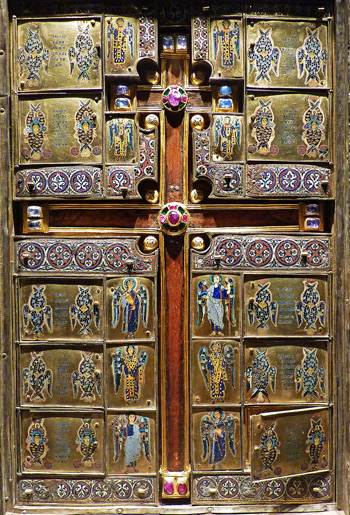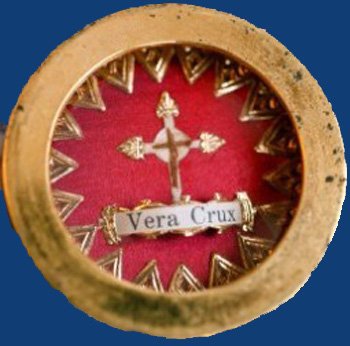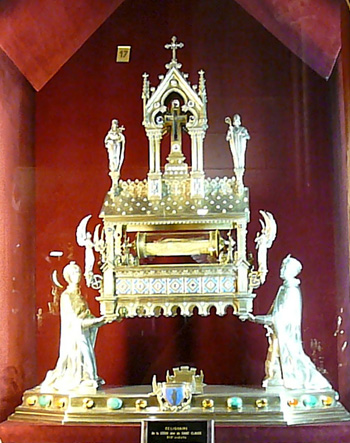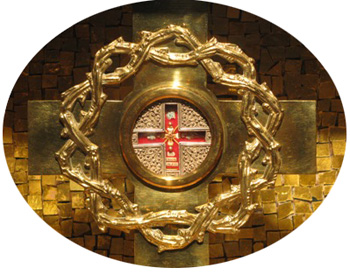Traditionalist Issues
 |
 |
 |
 |
 |
 |
 |
Dialogue Mass - LXXXVII
Abolished to Please Protestants:
The Finding of the Holy Cross Feast
Until the time of the Pseudo-Reformation, it was generally believed by Christians of the East and the West that St. Helena had indeed found the original Cross. But, centuries later, came the Protestant Pseudo-Reformation whose adherents, driven by their animosity to the veneration of relics, bitterly contested the validity of this tradition, which became the target of ridicule in Protestant circles from the 16th century to the present day.
Luther’s invectives
Luther’s condemnation of what he termed “gross and palpable lies about the Holy Cross” (1) was directed not just against whatever fraudulent claims that might have been circulating in his day, but against the genuine relics of the Cross approved by the Church since the 4th century.
St Thomas More, a contemporary, quoted from one of Luther’s sermons that if he had “pieces of the Holy Cross in his hand,” he would put them “where never sun should shine on them.” (2) In the same sermon, Luther objected to the devout custom of embellishing relics of the Holy Cross with precious metals, stating that “there is so much gold now bestowed about the garnishing of the pieces of the Cross… that there is none left for poor folk!” (3)
Calvin’s denigration
John Calvin made two jibes that caught the public imagination in his time and have remained in currency among Protestants to the present day. First, he lampooned the whole idea of there being an extant relic of the Cross, when he famously quipped:
 “If we were to collect all these pieces of the true cross exhibited in various parts, they would form a whole ship’s cargo.” (4)
“If we were to collect all these pieces of the true cross exhibited in various parts, they would form a whole ship’s cargo.” (4)
Little did he realize that one day someone would challenge this statement and expose it as a piece of scurrilous nonsense. In actual fact, it has been scientifically calculated that if all the wood historically authenticated as part of the True Cross were put together, they would make up less than 10% of the volume of one whole cross big enough to hang a man upon.
In the 19th century a French architect, Charles Rohault de Fleury, embarked on a monumental programme of research into Calvin’s claim, and published his results in 1870. (5) After extensive travels, he made an exhaustive catalogue of all known relics of the Cross throughout the world, giving the exact measurements, volume and physical description of each one.
He even included portions which were known to have existed but had been lost or destroyed, estimating their size from historical records. Most, it transpired, were so small – merely splinters or minuscule fragments – that they had to be measured in cubic millimeters.
When all the figures were added up, the grand total came to a small fraction of the volume of a cross used by the Romans for executions. With a ratio of 180:5, (6) we can justifiably conclude that the scandal was not that there should be so many relics existing, but that there should be so disappointingly few.
De Fleury received a personal letter from Pope Pius IX expressing the Pontiff’s appreciation for his scholarly and painstaking research. (7)
An impious invention
Calvin’s second jibe against the Holy Cross was no less ludicrous – and enduring – than the first:
 “They have invented the tale that, whatever quantity of wood may be cut off this true cross, its size never decreases.” (8)
“They have invented the tale that, whatever quantity of wood may be cut off this true cross, its size never decreases.” (8)
But, whoever invented the tale – and we know that Erasmus was influential in its dissemination (9) – it gave a whole new meaning to the term “Invention of the Holy Cross” – the title given to the feast in the pre-1960 Calendar, derived from the Latin inventio (“finding”).
The 16th century heretics blamed St. Paulinus, Bishop of Nola (354-431) as the source of the tale (which they themselves had invented) by tendentiously interpreting a passage from one of his letters. This is used, even today, as “proof” that Catholic doctrine is grounded in magic and superstition.
What did St. Paulinus really say?
But, a correct reading of his letter in the original Latin yields no such interpretation. When St. Paulinus sent a piece of his own relic of the Holy Cross in 403 to his friend, Sulpicius Severus, (10) he wrote an accompanying letter apologizing for the embarrassingly small size of the gift – he described it as “almost an atom of a small sliver” (11) – and explaining its provenance, as follows.
Bishop John of Jerusalem (St. Cyril’s successor) had given a tiny fragment of the Cross to the wealthy and pious lady, Melania, (12) who in turn gave a portion of it to St. Paulinus, who sent an even tinier fragment of his nanoscopic particle to Severus.
This raises a logical question that never seems to have occurred to Calvin and the critics of the True Cross. If, as they derisively claimed, Catholics believed that it spontaneously replaced any portions taken from it, so that it went on multiplying itself endlessly, why did Catholics for centuries go to such extraordinary lengths to conserve it by dividing it into infinitesimally small fragments?
 ]
St. Paulinus explained the importance of the tiny particle of the Cross: “Let not your faith shrink because the eyes of the body behold evidence so small; let it look with the inner eye on
the whole power of the Cross in this tiny segment.” (13)
]
St. Paulinus explained the importance of the tiny particle of the Cross: “Let not your faith shrink because the eyes of the body behold evidence so small; let it look with the inner eye on
the whole power of the Cross in this tiny segment.” (13)
He went on to say that, even though the “inanimate wood” (materia insensata) of the Cross is “daily divided” (quotidie dividua), it has “living power” (vim vivens) “to obtain the great grace of faith and many blessings.”
In other words, the “power of the Cross” resides in all its scattered fragments, so that it “should remain whole and entire (ut… quasi intacta permaneat) to those who avail themselves of it, and always undiminished (et semper tota) to those who venerate it.” (14)
It has escaped the Protestant critics that St. Paulinus was referring to the mystical significance of the life-giving Cross (15) which, in its spiritual dimension, cannot suffer diminution, no matter how many people draw from its graces. But, to a Catholic, it is obvious that he was speaking rhetorically of the inexhaustible riches of the Cross. (16)
The letter contains no evidence of the material substance of the original Cross expanding to replace the parts taken from it. Had that been the case, surely St. Paulinus would have sent a larger piece, if only to save embarrassment. (17)
In fact, pieces of the True Cross were in such short supply that only people with good connections to the Bishop of Jerusalem (like Melania) were privileged to obtain a fragment. Most pilgrims to Jerusalem had to be content with blessed oil that had been in contact with a relic of the True Cross. (18)
And the tradition of venerating an ordinary cross on Good Friday, where a piece of the True Cross was lacking, would not have arisen if the Church had a never-ending supply of wood from the original source.
Protestants influenced Catholic liturgical reform
The post-Reformation period produced many influential works that established the foundation for anti-Catholic polemics against the veneration of relics, particularly of the True Cross. Anyone who is familiar with the ensuing deluge of books, pamphlets, tracts, articles and sermons produced by Protestant churchmen over the following 400 years can see the extent to which abhorrence of this Catholic tradition is embedded in their religion and culture.
 Their main objection to the Finding of the Cross was its supernatural underpinnings. St. Helena’s vision was dismissed by Calvin as a “foolish curiosity, and a silly and inconsiderate devotion, which prompted Helena to seek for that cross.” (19) The miracle of healing wrought by the Cross was disbelieved and ridiculed from then on.
Their main objection to the Finding of the Cross was its supernatural underpinnings. St. Helena’s vision was dismissed by Calvin as a “foolish curiosity, and a silly and inconsiderate devotion, which prompted Helena to seek for that cross.” (19) The miracle of healing wrought by the Cross was disbelieved and ridiculed from then on.
Protestant mythology
As Calvin’s jibe was taken up by Protestant controversialists, it soon achieved the status of an urban myth. The more it was repeated, the more it was believed. By the 20th century, it was still feeding the popular imagination, so much so that the feast day was regarded as an embarrassing manifestation of irrationality and superstition by progressivist Catholics.
Is it not grotesque that, under pressure from “ecumenism,” the members of the 1960 Liturgical Commission decided to eliminate the Finding of the Holy Cross? And that the historic attacks on the Catholic Faith were used to justify the liturgical marginalization of this feast? But this could not have happened if Pope John XXIII had not connived at their efforts to de-Catholicize the traditional liturgy.
 Continued
Continued

Luther’s invectives
Luther’s condemnation of what he termed “gross and palpable lies about the Holy Cross” (1) was directed not just against whatever fraudulent claims that might have been circulating in his day, but against the genuine relics of the Cross approved by the Church since the 4th century.
St Thomas More, a contemporary, quoted from one of Luther’s sermons that if he had “pieces of the Holy Cross in his hand,” he would put them “where never sun should shine on them.” (2) In the same sermon, Luther objected to the devout custom of embellishing relics of the Holy Cross with precious metals, stating that “there is so much gold now bestowed about the garnishing of the pieces of the Cross… that there is none left for poor folk!” (3)
Calvin’s denigration
John Calvin made two jibes that caught the public imagination in his time and have remained in currency among Protestants to the present day. First, he lampooned the whole idea of there being an extant relic of the Cross, when he famously quipped:

Protestants detested that gold and jewels were used to honor the True Cross, above, Limburg reliquary
Little did he realize that one day someone would challenge this statement and expose it as a piece of scurrilous nonsense. In actual fact, it has been scientifically calculated that if all the wood historically authenticated as part of the True Cross were put together, they would make up less than 10% of the volume of one whole cross big enough to hang a man upon.
In the 19th century a French architect, Charles Rohault de Fleury, embarked on a monumental programme of research into Calvin’s claim, and published his results in 1870. (5) After extensive travels, he made an exhaustive catalogue of all known relics of the Cross throughout the world, giving the exact measurements, volume and physical description of each one.
He even included portions which were known to have existed but had been lost or destroyed, estimating their size from historical records. Most, it transpired, were so small – merely splinters or minuscule fragments – that they had to be measured in cubic millimeters.
When all the figures were added up, the grand total came to a small fraction of the volume of a cross used by the Romans for executions. With a ratio of 180:5, (6) we can justifiably conclude that the scandal was not that there should be so many relics existing, but that there should be so disappointingly few.
De Fleury received a personal letter from Pope Pius IX expressing the Pontiff’s appreciation for his scholarly and painstaking research. (7)
An impious invention
Calvin’s second jibe against the Holy Cross was no less ludicrous – and enduring – than the first:

Scientifically demonstrated that the existing fragments were less than the bulk of the True Cross
But, whoever invented the tale – and we know that Erasmus was influential in its dissemination (9) – it gave a whole new meaning to the term “Invention of the Holy Cross” – the title given to the feast in the pre-1960 Calendar, derived from the Latin inventio (“finding”).
The 16th century heretics blamed St. Paulinus, Bishop of Nola (354-431) as the source of the tale (which they themselves had invented) by tendentiously interpreting a passage from one of his letters. This is used, even today, as “proof” that Catholic doctrine is grounded in magic and superstition.
What did St. Paulinus really say?
But, a correct reading of his letter in the original Latin yields no such interpretation. When St. Paulinus sent a piece of his own relic of the Holy Cross in 403 to his friend, Sulpicius Severus, (10) he wrote an accompanying letter apologizing for the embarrassingly small size of the gift – he described it as “almost an atom of a small sliver” (11) – and explaining its provenance, as follows.
Bishop John of Jerusalem (St. Cyril’s successor) had given a tiny fragment of the Cross to the wealthy and pious lady, Melania, (12) who in turn gave a portion of it to St. Paulinus, who sent an even tinier fragment of his nanoscopic particle to Severus.
This raises a logical question that never seems to have occurred to Calvin and the critics of the True Cross. If, as they derisively claimed, Catholics believed that it spontaneously replaced any portions taken from it, so that it went on multiplying itself endlessly, why did Catholics for centuries go to such extraordinary lengths to conserve it by dividing it into infinitesimally small fragments?
 ]
]
A precious reliquary of the True Cross
in Notre Dame in Paris
He went on to say that, even though the “inanimate wood” (materia insensata) of the Cross is “daily divided” (quotidie dividua), it has “living power” (vim vivens) “to obtain the great grace of faith and many blessings.”
In other words, the “power of the Cross” resides in all its scattered fragments, so that it “should remain whole and entire (ut… quasi intacta permaneat) to those who avail themselves of it, and always undiminished (et semper tota) to those who venerate it.” (14)
It has escaped the Protestant critics that St. Paulinus was referring to the mystical significance of the life-giving Cross (15) which, in its spiritual dimension, cannot suffer diminution, no matter how many people draw from its graces. But, to a Catholic, it is obvious that he was speaking rhetorically of the inexhaustible riches of the Cross. (16)
The letter contains no evidence of the material substance of the original Cross expanding to replace the parts taken from it. Had that been the case, surely St. Paulinus would have sent a larger piece, if only to save embarrassment. (17)
In fact, pieces of the True Cross were in such short supply that only people with good connections to the Bishop of Jerusalem (like Melania) were privileged to obtain a fragment. Most pilgrims to Jerusalem had to be content with blessed oil that had been in contact with a relic of the True Cross. (18)
And the tradition of venerating an ordinary cross on Good Friday, where a piece of the True Cross was lacking, would not have arisen if the Church had a never-ending supply of wood from the original source.
Protestants influenced Catholic liturgical reform
The post-Reformation period produced many influential works that established the foundation for anti-Catholic polemics against the veneration of relics, particularly of the True Cross. Anyone who is familiar with the ensuing deluge of books, pamphlets, tracts, articles and sermons produced by Protestant churchmen over the following 400 years can see the extent to which abhorrence of this Catholic tradition is embedded in their religion and culture.

St. Helena's finding of the Cross dismissed by Protestants as a foolish myth
Protestant mythology
As Calvin’s jibe was taken up by Protestant controversialists, it soon achieved the status of an urban myth. The more it was repeated, the more it was believed. By the 20th century, it was still feeding the popular imagination, so much so that the feast day was regarded as an embarrassing manifestation of irrationality and superstition by progressivist Catholics.
Is it not grotesque that, under pressure from “ecumenism,” the members of the 1960 Liturgical Commission decided to eliminate the Finding of the Holy Cross? And that the historic attacks on the Catholic Faith were used to justify the liturgical marginalization of this feast? But this could not have happened if Pope John XXIII had not connived at their efforts to de-Catholicize the traditional liturgy.

A relic of the True Cross
- Martin Luther, “An Exhortation to the Clergy Assembled at the Diet of Augsburg” (1530), Works, Philadelphia: A.J. Holman Company, 1931, vol. 4, p. 34.
- “A Dialogue Concerning Heresies,” The Complete Works of St. Thomas More, Yale University Press, 1981, vol. 6, p. 50. Luther’s remark was taken as meaning that he would bury them in the ground, which is ironic as that is exactly what the enemies of the Cross of Christ did after the Crucifixion.
- Ibid.
- John Calvin, Treatise on Relics, 1534. New variants of Calvin’s quote are heard today, e.g., that there would be enough wood “to fill a ten-ton truck, or build a battleship/ a replacement for Noah’s Ark/ a bridge from Europe to America/ a ladder to the moon.”
In the same work, Calvin added: “the desire for relics is never without superstition, and what is worse, it is usually the parent of idolatry.” - Charles Rohault de Fleury, Mémoire sur les instruments de la Passion de Notre Seigneur Jésus-Christ (Dissertation on the Instruments of the Passion of Our Lord Jesus Christ), Paris, L. Lesort, 1870.
- Basing his figures on historical data of the 1st century, De Fleury estimated that the volume of a whole cross would be about 180,000,000 cubic mm., and he compared this to the collective volume of the relics which was less than 5,000,000 cubic mm. (Ibid., p.163) He also stated that, even if the volume of known relics were tripled to 15,000,000 cubic mm., it would still be less than 10% of a whole cross. (Ibid., p. 59)
- This letter, dated April 7, 1870, is printed in full at the beginning of De Fleury’s book. In it, Pope Pius IX commended the author for having “annihilated the sophistical arguments and mockery” of those who denigrated the authentic relics of the Holy Cross. And he complimented him on the scientific knowledge, laborious efforts and arduous travels that made the research a valuable defense of the True Cross.
- J. Calvin, Treatise on Relics, 1534.
- Desiderius Erasmus, “The Religious Pilgrimage” in The Colloquies of Desiderius Erasmus , London: Gibbings and Company, 1900, vol. 2, p. 220. (First published in 1518) Erasmus wrote a satirical skit of a pilgrimage to the shrine of our Lady of Walsingham, in which Ogygius says to his friend, Menedemus: “And they tell us the same stories about Our Lord’s Cross, that is shown up and down, both publicly and privately, in so many places, that if all the fragments were gathered together, they would seem to be sufficient loading for a good large ship; and yet Our Lord himself carried the whole Cross upon his shoulders.”
- Severus was a disciple and biographer of St. Martin de Tours.
- “Segmento paene atomo hastulae brevis”
- Melania the Elder (350-410), a relative of St. Paulinus, was from a wealthy and prestigious Roman family. She lived a strictly ascetic life and founded a monastery in Jerusalem where she was well-known to Bishop John. St. Paulinus made several references to her in his letters to Severus.
- “Non angustetur fides vestra carnalibus oculis parva cernentibus, sed interna acie totam in hoc minimo vim crucis videat.” (Ibid., p. 268, §2)
- Paulinus of Nola, Epistolae, Epist. XXXI in Corpus Scriptorum Ecclesiasticorum Latinorum (volume 29), p. 274, §6.
- Paulinus reinforces this concept in the next sentence: “Assuredly, it draws this power of incorruptibility, of indestructible integrity, from the Blood of that Flesh that endured death, yet did not see corruption.”
- A little known fact about St. Paulinus was the eloquence of his literary style. Having attended the school of rhetoric and poetry established in his native Bordeaux by the poet and teacher Ausonius (310–395), he wrote Latin poetry in the style of Virgil, Horace and Ovid, which can still be read today. Even his prose style was often rhetorical and florid, as can be seen in his many letters and exemplified in the letter to Severus quoted above.
- This would have mattered greatly to St. Paulinus: it was characteristic of him to feel embarrassment at the smallness of a gift. When he sent a few game birds to his friend, Gestidius, he mentions his “embarrassment at their small number,” begs his friend’s pardon, and hopes that “the meagre gift is not uncivil.” (P. G. Walsh, The Poems of St. Paulinus of Nola, Paulist Press, 1974, p. 31)
- The oil was placed in small flasks called ampullae, which were worn around their neck.
- J. Calvin, Treatise on Relics, 1534.

Posted June 19, 2019
______________________
______________________
 Volume I |
 Volume II |
 Volume III |
 Volume IV |
 Volume V |
 Volume VI |
 Volume VII |
 Volume VIII |
 Volume IX |
 Volume X |
 Volume XI |
 Special Edition |


